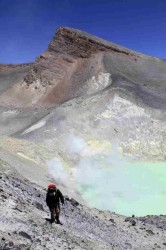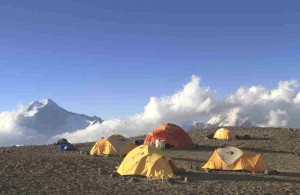Searching for Extremophiles: Blog Four
Click here to see all Climate Change blog entries.
It is now our fifth day at 15,750 feet. We had originally planned for 3-4 days at this camp, however, in the last few days the winds above 16,000 feet have steadily increased, with gusts up to 55 mph. We are waiting for a break in the weather to begin setting up our larger tents next to the glacier. In the meanwhile, our team has begun organizing gear and building the drill at the 18,270 foot camp.

The hike to the camp involves climbing up steep slopes to the rim of Tupungatito crater, where you get an amazing view of the Andes and can peer into Argentina. It’s another mile following the crater rim to reach the glacier. In addition to breathtaking views of the mountains, once on the rim you can look down into one of Tupungatito’s craters and see an incredible bubbling volcanic lake. The lime-green color of the water, the yellow, sulfur-stained crater walls, and the constant hissing of escaping toxic gases convey a beautiful but hostile Martian-like environment. Ironically, these are the types of environments in which many biologists are searching for life. The organisms that thrive in extreme environments like Tupungatito’s acidic volcanic lakes are referred to as “Extremophiles.” Yesterday, our team assisted a CECS biologist in the collection of water samples from the lake. We had to wear filtered masks and goggles as exposure to the fumes can be very hazardous. The experience was fantastic even though hauling 50 pound water containers up steep, sandy slopes at 17,000 feet was exhausting and the mask seemed at some points to limit oxygen as much as the toxic gases. The biologist is currently heading back to his lab in Valdiva and we’re all very interested to see what he finds.

Whether we are acclimatizing, preparing our gear, or jumping into craters, our Arriero (cowboy) friends have continued to assist us along the way. They recently carried up roughly two-and-half weeks worth of food. The arrival of new supplies like bacon, cheese, tuna, and (for some) marmite was thoroughly celebrated. It’s always nice when the Arrieros come to camp. They’re always in great spirits, laughing and joking around. Their laid-back nature makes it easy to forget how difficult their profession is. It requires a great amount of skill and stamina, and yet they make it look simple. We’re all very curious about the Arriero way of life and how it has been passed down from generation to generation and how it coincides with the modern world. Sadly, the Arrieros say the next generation will most likely choose other professions as Chile’s economy and urbanization have created job demands elsewhere. During their last visit it was nice to see that they were accompanied by a young Arriero named Luis.
In addition to preparing for the ascent of Tupungatito and the ice core drilling, we are also continually planning the descent from the glacier. The 400 feet of ice cores we plan to collect will be carried on the mules in insulated boxes with dry-ice for two days to the safety of a freezer truck at the Colorado Valley trail head. We just heard today that the bridge that caused us delays a couple weeks ago is again flooded. If it remains flooded the truck will be unable to cross so we will need to begin planning for that possibility. The dry ice can only protect our ice cores from melting for 24-36 hours.
In the past couple of days two team members have had to leave. Rodrigo Zamora left to conduct radar surveys in northern Chile on another CECS expedition. Dan Dixon is returning home to Maine to his wife Erika to await the arrival of their first child. Our best wishes go out to the Dixons.
